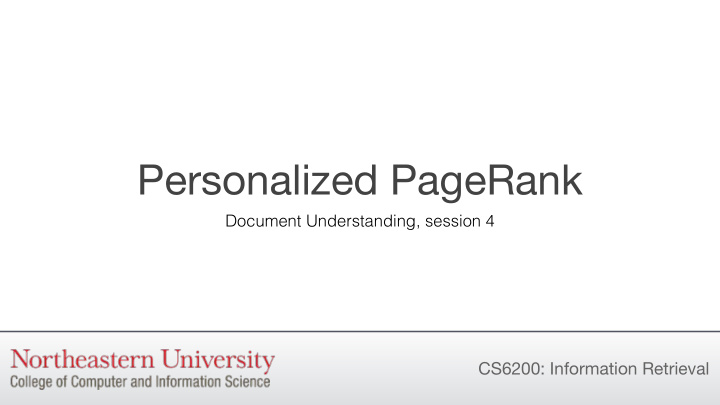



Personalized PageRank Document Understanding, session 4 CS6200: Information Retrieval
Conditional PageRank The original PageRank score is a B 2 A 1 distribution over the entire Internet. We are often interested in quality B 3 scores for more restricted subsets of the Internet, e.g. for pages on a A 2 B 1 particular topic. The fundamental trick is to modify the teleportation probability and then C 1 follow links as usual. Pages with Topic Labels
Obtaining Page Topic Labels Topic labels can be obtained from an Internet directory such as dmoz.org or yahoo.com. Topics can also be inferred using semi-supervised learning: given some labels, we can calculate the most probable topic for unlabeled pages. We don’t need accurate topic labels for all pages; we will follow links to unlabeled pages. The Open Directory Project
Topic-specific PageRank Once we have our topic labels, we B 2 A 1 modify PageRank teleportation to teleport only to the set T of pages with the specified topic t . B 3 Some set Y ⊇ T of pages will have a A 2 B 1 steady-state PageRank distribution from this process. The pages in Y have topic-specific C 1 PageRank scores for the topic, π t . Dotted edges represent teleportation options
Mixing Topics Suppose a user is interested multiple topics. We can compute a Personalized PageRank by teleporting with a distribution according to their interests. ‣ For instance, 60% of the time we teleport to a sports page and 40% of the time to a politics page. Recalculating PageRank for each user is prohibitively expensive, but it turns out we don’t have to. The final distribution is just a linear combination of topic-specific PageRank scores: 0.6 π s + 0.4 π p .
Does Personalization Help? Personalized PageRank scores make intuitive sense, but it’s not clear that they help much. They tend not to be used in practice due to several concerns. • Privacy – A detailed log of users’ web page preferences can reveal sensitive information about their political opinions, income levels, etc. • Users change – People gain and lose interests over time, and it isn’t clear how to update models. They also run queries related to new topics, and a personalized model might mislead the search engine. • Clear queries don’t need it – If the information need of the query is clear enough, we don’t need this kind of topic-based help to perform well.
Wrapping Up Topic and individual based PageRank scores seem a promising avenue for improving performance of certain queries. However, it’s not clear how to best put them to use in real world situations. Next, we’ll continue exploring web page topics by learning how to infer topics from the document text alone.
Recommend
More recommend